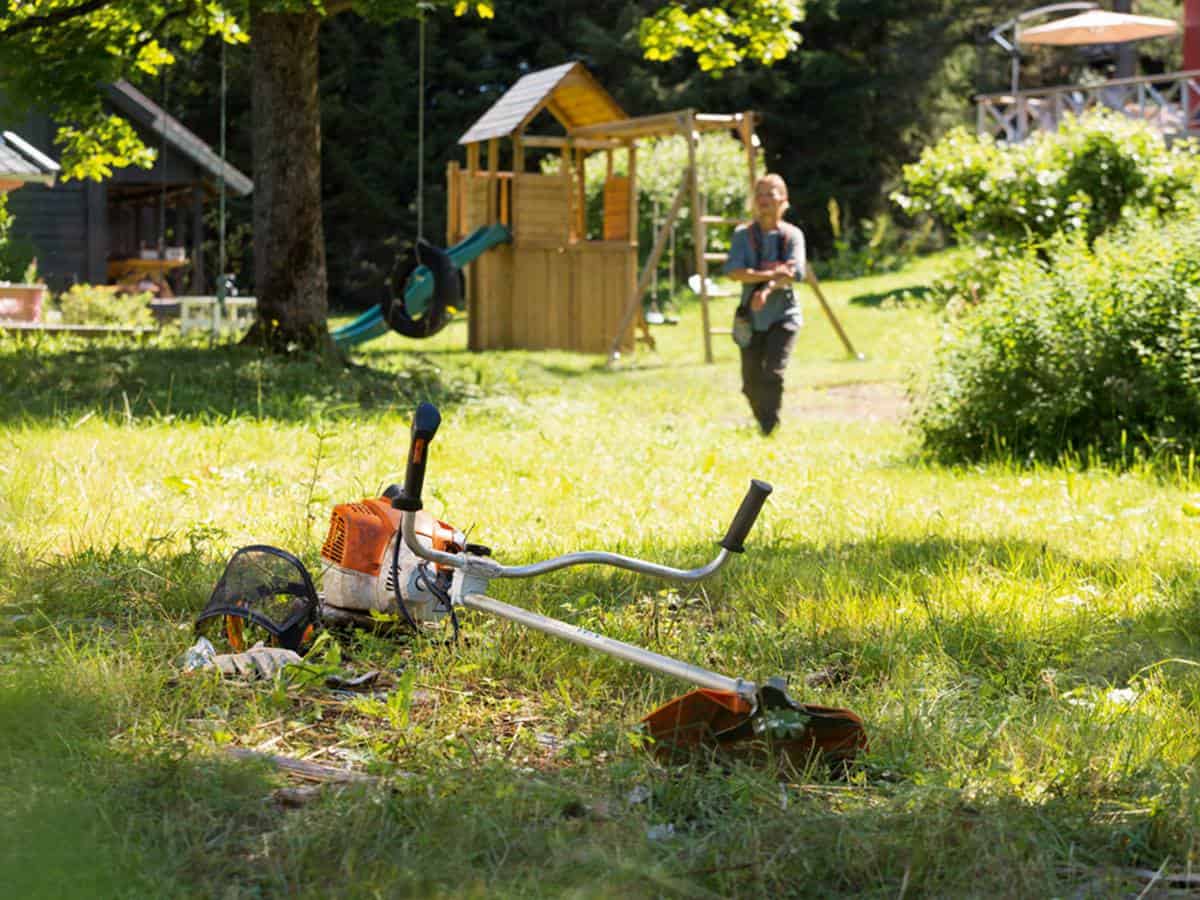Have a great day!
You might be standing in your backyard, admiring its beauty, until you look down and see the unruly weeds mocking your otherwise perfect lawn. I’m with you on this, having battled those stubborn plants myself – did you know that a string trimmer can cause serious damage to trees and shrubs if not used properly? My aim here is to highlight how dangerous string trimmers can be while providing safety measures and precautions you could follow for safe usage.
Let’s dive into the nitty-gritty details of safeguards so no one has to fear their weed whacker again!
Contents
Are String Trimmers Dangerous?
Yes, string trimmers can be dangerous. They spin fast and have sharp edges. This makes it easy for them to hurt people or harm things around you. I could cut my skin if I’m not careful when using a string trimmer.
Any tool that spins fast can throw objects around. A flying stone or stick from a string trimmer can hit me in the eye. Even if I do not touch the cutter, an accident may happen! Others near me are also at risk of being hit by flying debris.
Both battery-powered and plug-in models pose this risk. So yes, using a string trimmer needs care even though it is a common lawn tool.
Read more: Which Way Do You Walk With A String Trimmer?
What Are The Risks Of String Trimmers?
The risks of string trimmers include lacerations, eye damage, and bruises.
Lacerations
String trimmers can cause deep cuts, also known as lacerations. The sharp blades move very fast and can cut the skin easily. Even your fingers are at risk if they get too close to the blades.
These types of wounds hurt a lot and may need medical care right away. Sometimes, parts of the string trimmer may fly off while you’re using it. Black & Decker had to take back some of their trimmers because bits would come loose and fly around as dangerous objects that could cut you.
This is why I always tell lawn owners how important it is not to mess with a running string trimmer!
Eye damage
String trimmers can hurt your eyes. Small bits of grass and dirt fly up as you use them. These tiny pieces can hit your eye with high speed. This is called an eye injury or eye damage.
The American Academy of Ophthalmology says this kind of harm can lead to other health issues. About one-third of all hurts from gas-powered hedge trimmers involve the eyes, so it’s a real risk! Protecting your sight is key when using power tools like string trimmers or edgers.
Bruises
Contact with the string of a string trimmer can cause bruises on your skin. The power of the tool determines how severe these bruises might be. When the string grazes or hits your skin, it can leave redness or minor bruising.
But if you have more significant contact with the trimmer’s string, you may end up with deeper cuts and lacerations that require medical attention. So it’s essential to handle a string trimmer with caution to avoid these bruises and injuries.
Safety Tips for Using String Trimmers
Always wear safety goggles, gloves, and sturdy shoes when operating a string trimmer. Stay alert and make sure to follow the manufacturer’s instructions for proper use. Handle the tool with care to avoid accidents.
Learn more about how to safely operate a string trimmer in our blog post!
Read more: Can A String Trimmer Start A Fire?
Wear appropriate safety gear
It’s important to wear the right safety gear when using string trimmers. Here’s what you need:
- Safety goggles or glasses to protect your eyes from flying debris.
- Ear protection, like earplugs or earmuffs, to shield your hearing from loud noise.
- A sturdy pair of gloves to keep your hands safe from cuts and scratches.
- Long pants and a long – sleeved shirt to cover your skin and protect against debris.
- Steel – toe boots for extra foot protection.
Make sensible choices
When operating a string trimmer, it is important to make sensible choices to ensure your safety and the safety of those around you. This means using common sense and following the manufacturer’s guidelines for proper usage.
Avoid using the trimmer in wet or slippery conditions, as this can increase the risk of accidents. It is also advisable to keep children and pets away from the area where you are working with a string trimmer.
By making sensible choices, you can minimize the potential risks associated with using this tool and enjoy a safer lawn care experience for everyone involved.
Handle the tool properly
When using a string trimmer, it’s important to handle the tool properly. Here are some tips to keep in mind:
- Hold the handle of the trimmer with both hands for better control and stability.
- Keep a firm grip on the tool throughout operation to avoid any accidents.
- Always follow the manufacturer’s instructions for starting, stopping, and operating the trimmer.
- Don’t force the trimmer into dense vegetation or try to cut larger branches than recommended.
- If you encounter obstacles while trimming, stop the tool and remove them before continuing.

Conclusion
In summary, string trimmers can be dangerous if proper safety precautions are not taken. The risks include lacerations, eye damage, and bruises. It is important to wear appropriate safety gear, make sensible choices, and handle the tool properly to avoid accidents.
Always prioritize safety when using a string trimmer to prevent injuries or damage.
FAQs
1. What are the potential hazards of using a string trimmer?
The potential hazards of using a string trimmer include cuts and injuries from the rotating cutting line, flying debris, and accidental contact with electrical cords.
2. How can I stay safe while using a string trimmer?
You can stay safe while using a string trimmer by wearing protective gear such as goggles, gloves, long pants, and closed-toe shoes. Additionally, always follow the manufacturer’s instructions and be cautious when working near obstacles or uneven surfaces.
3. Can children use a string trimmer alone?
No, children should never operate a string trimmer alone as it requires strength and coordination that may exceed their capabilities. It is important for adults to supervise and handle the equipment responsibly around children.





